Reserve Bank of Australia Annual Report – 1991 The Economy and Monetary Policy
The International Environment
The international environment in 1990/91 was characterised by a slowing in the rate of growth of the world economy, with potentially major implications for Australia. Big shifts in the terms of trade had been important factors, for example, in the slowing in economic activity in 1986, and the subsequent boom through 1988 and 1989.
Some slowing in world growth was inevitable. The long business cycle expansion which had begun in the major countries around 1983 was, by 1988, putting increasing pressure on productive capacity. This was not immediately reflected in a major lift in inflation, in large part because policy-makers around the world were determined not to allow inflation to get away from them. The response was a tightening of monetary policy, beginning in the United States in early 1988 and extending to most countries by the middle of 1989.
Of the major economies, the United States was the first to show evidence of slowing economic growth. As a result, monetary policy was eased cautiously in the second half of 1989, and more decisively after September 1990 as signs of recession multiplied. By the second half of 1990, the United Kingdom, with inflation peaking and the economy contracting, also began to ease. During this time, however, Japan and Germany were still tightening as their economies were growing strongly and pressure on domestic resources was mounting. In Japan the tighter monetary policy was adhered to, notwithstanding the adverse impact of large falls in share prices (and uncertainty in the property market) on some financial institutions. Japan finally eased monetary policy in July 1991; in Germany, where inflationary pressures from unification continued to increase, monetary policy was tightened further during 1991.
Overall, the slowdown in the world economy has been more pronounced than was thought likely a year ago, but the lack of synchronisation of business cycles in major countries has helped limit the severity of the downturn. Unlike the mid 1970s and 1982, when virtually all of the major countries went into recession simultaneously and aggregate OECD output declined, the world slowdown of 1991 will show slow but positive growth, with about half of the major countries having been in recession.

For the most part, inflation seems to have been reasonably well contained. There was a major threat from the Iraqi invasion of Kuwait in the second half of 1990 when oil prices rose sharply, reaching US$40 per barrel in early October.
But by March 1991, as the war concluded without major losses of oil production, prices had returned to levels of a year earlier. For the seven major OECD economies, the average CPI increase has remained around 5 per cent over the past year or so, compared with a previous peak of over 12 per cent in 1980. Inflation appears to be declining in the United States and the United Kingdom. It has stopped rising in Japan but it is moving up in Germany.

World industrial production has flattened out. Commodity prices have fallen, although generally by less than in the 1986 slowdown. From their peak in September 1989, Australian commodity prices (as measured by the Bank's Index) fell by 25 per cent to their most recent low point in February 1991. The main weakness was in rural prices, which fell by 38 per cent, with wool prices accounting for about half the fall. Non-rural prices held up better, but still fell by 15 per cent. More recently, however, commodity prices have started to rise again, led by wool and wheat; the Bank's Index in June was 9 per cent above its trough in February.
The world economy in 1992 is forecast to see a moderate pick-up in activity and a slowing in inflation. Earlier concerns about financial fragility in the United States and Japan have abated and the threats posed by developments in the Middle East have passed. The latest OECD forecast is for real GDP to grow by about 3 per cent in 1992, and for inflation to slow to about 3¾ per cent by the end of 1992. Among the major countries, growth in Germany is expected to slow, while the United States, Canada and the United Kingdom are forecast to recover. Japan should record moderate growth. Economic growth in the newly industrialising countries of Asia is expected to slow, but to rates which are still higher than in the OECD area.
On the basis of past experience, the prospective pick-up in world economic activity, together with the rise in Australian commodity prices that has already occurred, could be expected to herald some cyclical (but unquantifiable) improvement in Australia's terms of trade.
Domestic Economy
As in other countries, reducing the rate of inflation has been a major focus of monetary policy in Australia over recent years. During 1988 and 1989, the immediate task was to restrain the rapid growth in domestic demand, and particularly spending by the business sector. Although a rise in the investment share of GDP was welcome, it is clear now that too much of it was directed to the property sector, and too much was motivated by expectations of rising asset prices, rather than efforts to increase productive capacity. The rapid growth in demand threatened progress in winding back inflation. It also spilled over into imports, contributing to a jump in the current account deficit from around 4 per cent of GDP in 1987/88 to 6 per cent in 1989/90.
In these circumstances, and with the rate of inflation already high by world standards, there was no alternative but to tighten monetary policy. Interest rates were increased, with cash rates reaching 18 per cent in mid 1989, a rise of nearly 8 percentage points over the previous eighteen months.
By the end of 1989, it was clear that the proximate objective of monetary policy was being achieved. The boom in property prices had finished; prices had stabilised and, in some cases, were starting to fall. There were also early signs of a slowing in real economic activity – housing construction declined from very high levels, and businesses began to wind back their capital expenditure plans. Considering the strength of demand, inflation had been contained reasonably well. This outcome was aided by the modest appreciation of the Australian dollar, which reduced import prices, and by the various Accord arrangements which helped to contain wage claims.
At the beginning of 1990 it was judged that the level of interest rates appropriate in the earlier environment of rapid increases in spending and widely held expectations of rising asset prices was no longer required. Against this background, monetary policy was eased in several steps during the first half of 1990; the level of cash rates was lowered from a peak of around 18 per cent in January to around 15 per cent by early April.

The contraction in economic activity can be dated from about the middle of 1990, although the economy was clearly slowing before then. The national accounts show that in net terms there was some growth in spending and output in the middle two quarters of 1989/90, but that both started to fall in the June quarter of 1990.

Over the next four quarters, spending fell by a total of 5 per cent in real terms. The fall was concentrated most heavily in business investment, which had seen the largest increase through 1988 and early 1989. Capital spending by governments also fell. Consumer spending showed only sluggish growth, and declined in per capita terms. As the downturn in demand deepened, its effects on output were accentuated as businesses sought to reduce inventories in line with falling sales. Motor vehicle manufacturers in particular, and some of their component suppliers, moved to shut plants and/or work short time to help run down stocks.

Company profits declined, except in the mining sector where output and profits were boosted temporarily by high oil prices in the latter months of 1990. The share of corporate gross operating surplus in GDP declined, although the fall was smaller than in the recessions of either 1974 or 1982. After allowing for interest payments, however, the profit share has been at levels not much different from those in earlier recessions. The cost to businesses of servicing debt rose during the 1980s, reflecting rises in both gearing in the corporate sector and real interest rates.

The weakening in activity took some time to show up in the labour market. Although job vacancies started to fall in the second half of 1989, shortages of labour persisted in some sectors. Employment, in fact, continued to grow until the middle of 1990 and while declining thereafter, was still, in December 1990, at the same level as in the early months of that year. In the first half of 1991, however, it fell sharply. By June 1991 it had fallen by over 220,000 (or 2.8 per cent) from its peak. The fall was concentrated amongst full-time workers; part-time employment actually rose by about 47,000 over the same period. Overtime declined, and normal working hours were shortened in a number of industries. The rate of unemployment rose to an average of 9½ per cent by the June quarter of 1991, the highest since early 1984. Job vacancies continued to fall for most of this period; by mid 1991, they had fallen by about 70 per cent from their peak.

The downturn in real activity since mid 1990 has been similar in magnitude to that which occurred between late 1981 and the middle of 1983, but more severe than the mild slowdown that occurred in 1986. In the latest downturn, the fall in real GDP from the peak to date has been about 2 per cent, compared with 2½ per cent in the early 1980s. The fall in employment to date of 2.8 per cent compares with a 3.3 per cent decline in 1982/83.
The severity of the downturn exceeded most expectations. The absence of either a wages blow-out or a major world recession was seen as a likely ameliorating factor on this occasion. Other factors, however, were working in the opposite direction. The most important of these was the unhealthy position of corporate balance sheets. High levels of debt and high real interest rates strained businesses' capacity to service debt. Interest payments necessarily had first call on cash flow, which was slowing in line with the weakening economy. As businesses tightened their belts, they deferred or shelved investment plans, cut back on orders to reduce stock levels, and shed labour. It is also likely that productivity-enhancing economies, which were deferred in earlier buoyant times, have been pursued more vigorously over the last year – the shedding of labour in particular appears to have been very widespread on this occasion.
Balance-sheet problems were not confined to businesses. Financial intermediaries also felt the pinch, and some came under extreme pressure, particularly in Victoria. The fall in retail spending and employment was much more pronounced in Victoria than in the rest of Australia, giving this cycle more of a regional dimension than other recent recessions.

Adverse conditions in some parts of the rural sector acted to increase the severity of the recession as the year progressed. Incomes in the wool industry were cut by the collapse of the floor-price scheme. Wheat farmers also faced low prices, a result of good harvests in a number of countries and subsidy wars between major trading countries. Overhanging these developments was a substantial level of indebtedness for some farmers, with high funding costs and, in many cases, declining farm values.
The contraction in domestic spending was reflected in an improvement in Australia's balance of payments. From their peak in June 1989, imports of goods and services had fallen by 11 per cent, in volume terms, by early 1991. Growth in export volumes has been exceptionally strong. Over the two years to March 1991, exports of goods and services expanded by 21 per cent in volume terms. This growth was entirely in the non-rural sector, with major contributions coming from mining (up 27 per cent) and manufactures (an increase of 76 per cent).
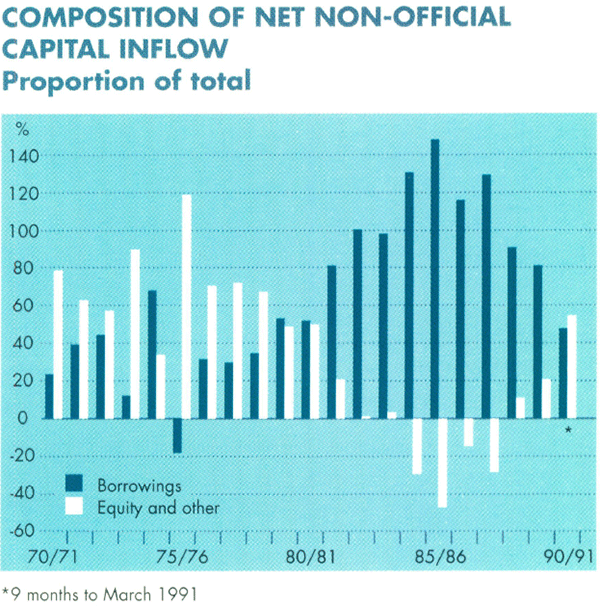
Despite a deterioration in the terms of trade of around 10 per cent since mid 1989, the improvement in trade volumes produced a substantial decline in the goods and services trade deficit in 1990/91. The net income and transfers account deficit remained large, however, reflecting the costs of servicing the increasing stock of foreign liabilities. For 1990/91 as a whole, the current account deficit of $15.3 billion was lower than had been forecast at the time of the Budget and lower than last year's figure of $22.3 billion. Nevertheless, it still amounted to 4 per cent of GDP.
The non-official capital account has seen a resumption over the past three years of net equity inflow, after several years of net outflow in the mid 1980s when Australian residents made large investments offshore. Preliminary figures for 1990/91 show net equity inflow to have been about the same as net debt inflow, as foreign interests bought into Australian corporate entities. This decline in international gearing parallels the tendency for firms to consolidate the structure of their balance sheets domestically. Australia's estimated net foreign debt at the end of March 1991 was $133 billion, an increase of $4 billion compared with a year earlier and equivalent to 35 per cent of GDP.
Monetary Policy
The easing of monetary policy which started in January 1990 continued during 1990/91. Overnight cash rates at the beginning of the financial year were around 15 per cent. They were reduced by 4½ percentage points, in five steps, during the year to around 10½ per cent by mid 1991; this compared with a peak of about 18 per cent in the second half of 1989. In line with the policy of informing the markets of significant developments, the Bank continued the practice of announcing these changes publicly as they occurred.
| 23 January 1990 | ½–1 |
|---|---|
| 15 February 1990 | ½ |
| 4 April 1990 | 1–1½ |
| 2 August 1990 | 1 |
| 15 October 1990 | 1 |
| 18 December 1990 | 1 |
| 4 April 1991 | ½ |
| 16 May 1991 | 1 |
There is no simple rule that determines the profile of changes in interest rates. The high nominal and real rates needed to slow the overheated economy in 1989 were clearly no longer required as the economy cooled but the extent and timing of the reductions were matters of judgment. Several intermediate indicators can provide some guidance – for example, the shape of the yield curve; the level of real interest rates themselves; growth in financial aggregates – but these rarely give an unequivocal signal. In the final analysis a judgment has to be made, weighing up progress in reducing inflation and the trend in economic activity.
The contraction of the economy which became apparent in the second half of 1990 highlighted the conflicting pressures on policy. Larger and/or more frequent reductions in interest rates would have helped to ease the immediate cash-flow problems of borrowers and might have had some influence on the path of economic activity. On the other hand, such actions could well have been construed by the public as a softening of the authorities' anti-inflation resolve. In that event any cushioning of the cyclical trough would be achieved at the cost of entrenching inflationary expectations at a higher level than might otherwise have prevailed.
This sort of short-term dilemma is always present, to some extent, in setting monetary policy. But constant adjustment of nominal interest rates in an attempt to steer the economy along some narrowly defined path of activity is the most costly form of resolution – at best a small short-term gain in activity in exchange for a large loss on inflation in the longer term. In the event, the focus was more on the need for medium-term adjustments to inflation, and attempts to fine-tune the economy overly in the short term were eschewed.
This did not mean that interest rates were unresponsive to the state of the economy. As well as being important in their own right the expected paths of activity and demand are clearly very important aspects to judgments about future inflation and inflationary expectations, and about the extent to which interest rates might be adjusted while still exerting downward pressure on inflation.
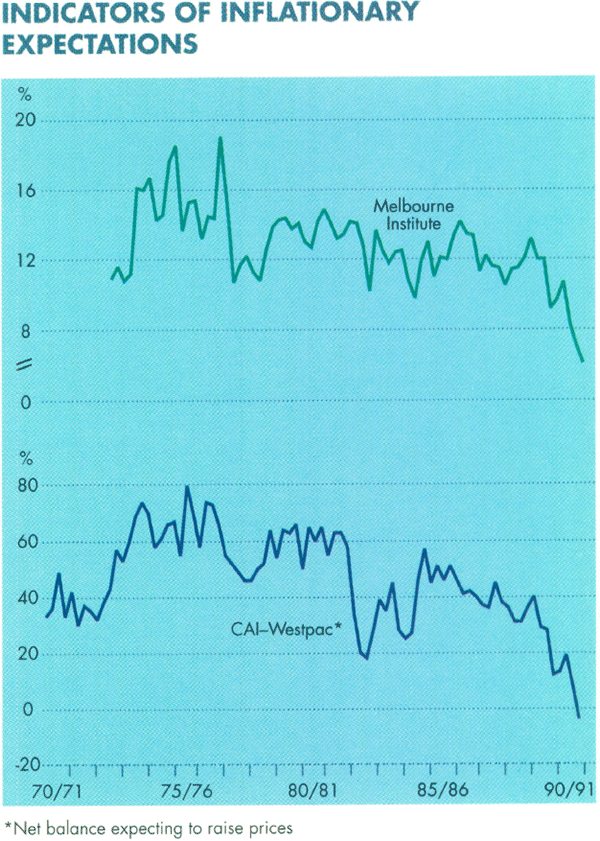
A major consideration in translating this medium-term focus into actual settings of interest rates was an assessment of the evidence on price expectations. While it is not possible to measure these with any precision, a number of sources provide clear evidence of a significant fall. The most direct measure comes from the Melbourne Institute survey, which showed the first sustained fall below 10 per cent since the survey began in the mid 1970s. Respondents' expectations have tended to incorporate an element of overstatement in the past, so too much precision should not be attached to the latest figure of 6 per cent. But the change in climate is clear. The latest CAI-Westpac survey of manufacturers also shows, for the first time since this question was introduced into the survey in 1966, a majority of respondents had lowered their selling prices, and expected to continue to do so. A third source of information on price expectations is the level of those interest rates most freely determined in the market without substantial official influence. That requirement is most closely approximated by interest rates on longer-term securities which effectively embody expectations about prices. Changes in the “long end” of the yield curve may, of course, reflect other factors as well, but the fall of over 2 percentage points during the past year clearly reflects a reduction in price expectations.
Even if these indicators had provided an exact measure of the fall in expected inflation, they could not be seen as placing a rigid limit on the extent to which nominal interest rates could decline. To lower cash rates pari passu with the fall in price expectations, would leave the effective stance of monetary policy – as measured by the real interest rate – unchanged. Given the large shift from expansion to contraction in economic activity over the past two years, this would have been inappropriate. The 7½ percentage point fall in cash rates since January 1990 was therefore significantly greater than the fall in price expectations.
Even so, real short-term rates remained high, consistent with keeping policy quite firm. Real rates at the long end of the yield curve remained high as well. By end July, ten-year bond yields were about 11 per cent, compared with the latest CPI-based estimate of inflation of less than 5 per cent, leaving Australian real bond yields at the high end of the international spectrum. To the extent that this reflects a premium for uncertainty about future inflation, it suggests that inflationary expectations need to be brought down further, although other factors may also contribute to this premium – particularly lingering concerns over medium-term balance of payments adjustment.
The Bank continued to monitor monetary aggregates in 1990/91. Deregulation altered the relationship between many of the aggregates and economic activity, making interpretation difficult, and 1990/91 proved no different from other recent years in this respect. The aggregates cannot provide a systematic guide to the timing and extent of policy adjustments, although they can serve as a supplementary source of information on the economy. Growth in both M3 and broad money slowed in 1990/91, as the need for intermediaries to fund new lending diminished, but the series continued to exhibit signs of instability. The narrower aggregates accelerated, with currency growth picking up markedly. In past cycles, this occurred when growth in spending picked up; in the present case, it appears to reflect more the effects of cash transactions reporting requirements and new arrangements for taxing interest, which have encouraged people to hold more wealth in cash. Concerns about the viability of some financial institutions also may have stimulated the desire to hold cash.
| Long | Short | |
|---|---|---|
| United States | 3.5 | 1.2 |
| Japan | 3.0 | 3.7 |
| Germany | 4.2 | 4.7 |
| United Kingdom | 4.4 | 5.3 |
| Australia | 6.0 | 5.2 |
| *Real interest rates are usually defined as nominal rates less the expected rate of inflation. However, for the purposes of this table, real rates are calculated by deducting the percentage change in the Consumer Price Index over the most recent twelve-month period from the nominal interest rate at the end of July 1991. Short interest rates are 90-day private paper, and long rates are ten-year Government bonds. | ||
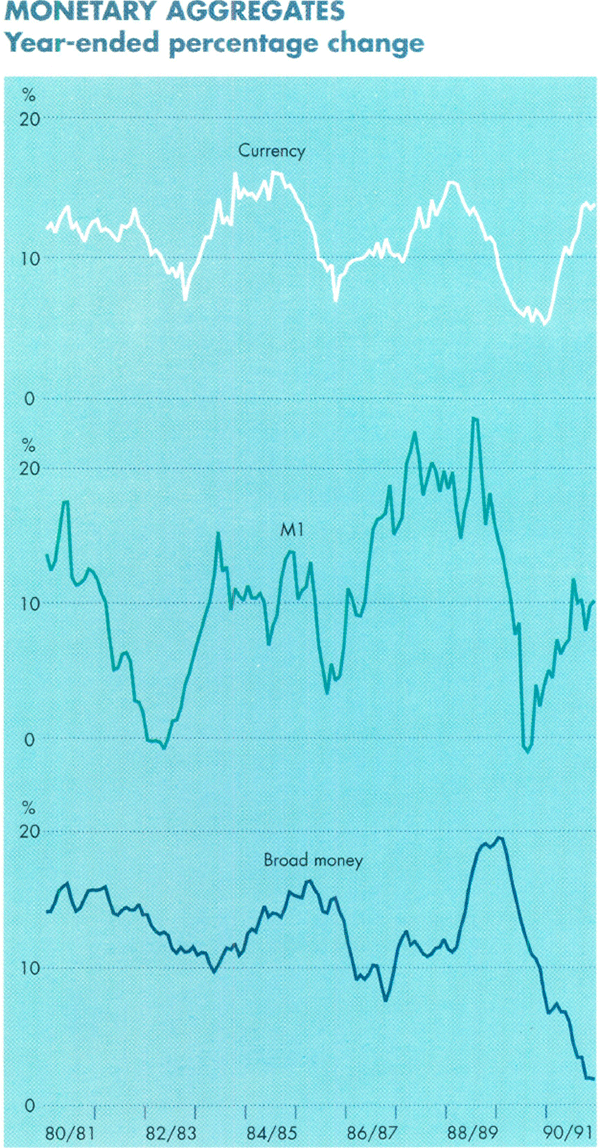
Attention has tended to focus in recent years more on the rate of expansion of financial intermediaries' credit than on money growth. In 1990/91, credit rose by 2 per cent, the lowest rate of growth ever recorded for this series. The slowing over the past two years has been particularly pronounced in the area of business credit.
How should this slowdown in credit be interpreted?
A considerable winding-back in credit growth was, of course, to be expected. The weakening economy, and falling inflation, meant that the demand for credit in nominal terms would slow. (Nominal spending fell in the year to March, for example, for the first time since the early 1960s.) In the past, credit has slowed in such circumstances; it has also tended to lag behind the growth in spending and income. There are, moreover, good reasons for not treating the relationship between credit and the economy in a mechanistic way. The ratio of credit to spending and income moved up much faster than its long-term trend in the second half of the 1980s, as businesses increased their gearing. Growth rates for credit of over 20 per cent per annum were common during that period. In the current period many companies are likely to seek to repay debt in efforts to get their balance sheets into better shape; in that event, the growth of credit could fall below the rate of nominal spending and income growth for a time.
As discussed elsewhere in this Report, the rapid growth of credit in the 1980s has considerably increased the problem loans for banks and raised issues for the Bank's supervisory responsibilities. From a monetary policy perspective, there has been a concern during the past year that lending institutions would over-react to their bad loans experience and, in effect, impose their own squeeze on the supply of credit to businesses. (This has been less of an issue for the personal sector, particularly given the indications that lending for housing was starting to pick up around the middle of 1991.) Similar concerns have been expressed in the United States and, more recently, in the United Kingdom.
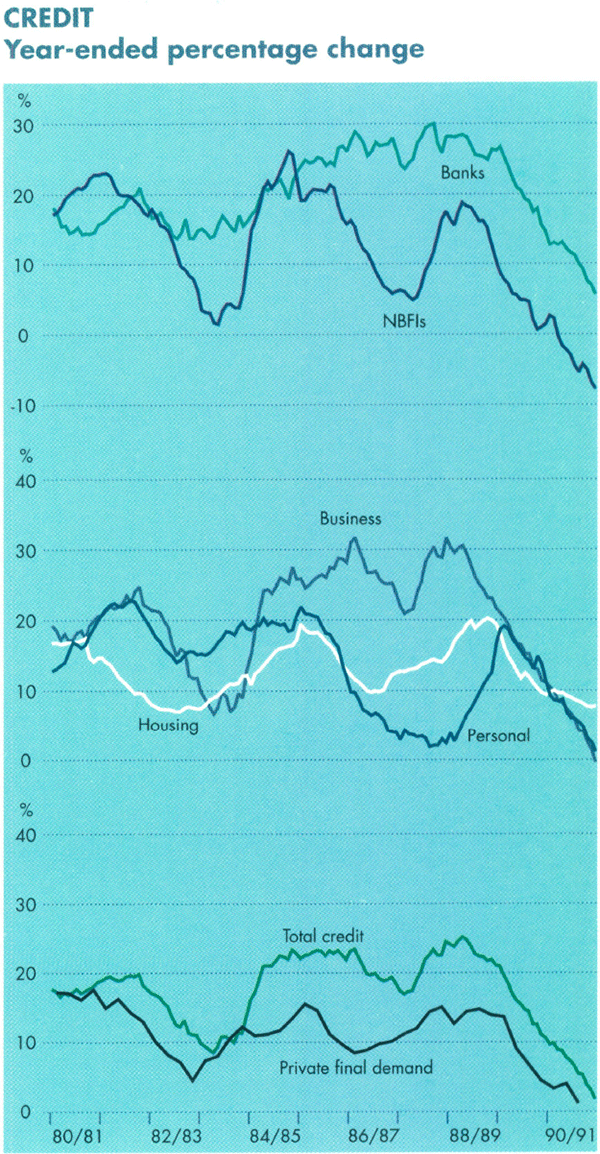
It is clear that intermediaries in Australia have reassessed their views of credit-worthiness, and have tightened assessment procedures for loan applications as a result. This, however, should be counted as a positive response to the earlier decline in standards, and does not necessarily imply a widespread shortage of credit for worthy borrowers. Anecdotal reports suggest that some lenders have treated some of their customers harshly, but there is no hard evidence to suggest that such treatment has been widespread. The credit figures themselves do not provide much help in this regard, being subject to a number of technical factors (provisions against bad loans, for example, reduce the measure of credit, while the practice of capitalising interest as part of a “work out” situation increases it).
More fundamentally, the credit figures do not provide any definitive way of distinguishing between demand and supply effects – any shift in the relationship between credit and economic activity could have as much to do with the demand for credit as with supply. To date, however, there is very little evidence that the growth in credit is all that different from what would be implied by past relationships with trends in activity, particularly if allowance is made for possible higher-than-normal repayments. In other words, any widespread credit squeeze initiated by intermediaries would have been expected to show up in even slower credit growth than has been observed.
In looking for other evidence of a possible supply-side “credit crunch”, the responses to questions on the availability of finance in the CAI-Westpac survey of manufacturers are of interest. These suggest that, while finance has been less readily available than in the boom years of 1988 and 1989, it is not as difficult to obtain as in the period of credit rationing in 1974. The statistics for the cancellation of credit facilities also do not suggest any unusually large increase in the calling-in of loans. In brief, the information available does not point to any widespread, bank-imposed “credit crunch”.
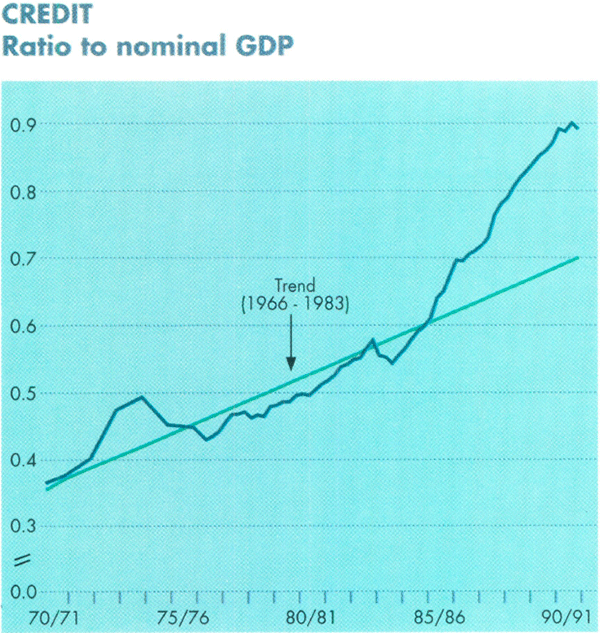
Inflation
With the weakening in domestic demand and continuing firm monetary policy, the downward trend in inflation, which had been emerging since the latter part of 1989, became more pronounced from mid 1990. Evidence of moderation in inflation had shown up during 1989/90 in some of the national accounts deflators and the various partial price indices, but not to any great extent in the Consumer Price Index. In 1990/91, however, the downward trend in inflation became much more evident, including in the widely used CPI measure which slowed sharply.
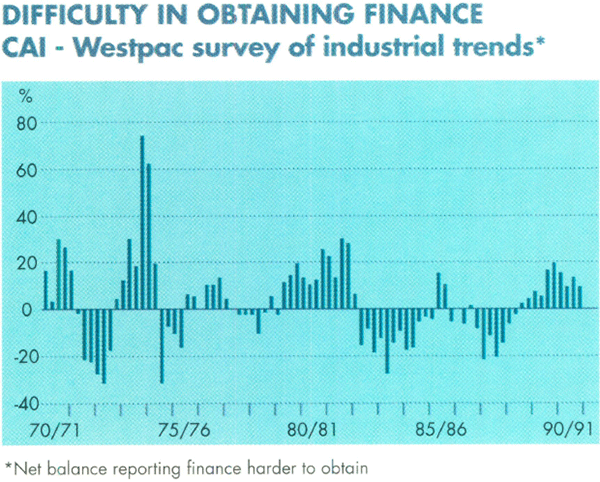
This slowing is partly attributable to the weaker economy. As growth in consumer spending slowed, the incidence of discounting in the retail sector became widespread and profit margins were squeezed, particularly in the area of consumer durables. Over the year to March, prices for household appliances rose by only 1.4 per cent while automobile prices fell by 1.2 per cent. The tighter conditions also have spread to sectors where price-setting traditionally has been unaffected by cyclical conditions; increases in residential and retail rents, for example, have slowed, and the price of commercial property appears to have fallen sharply.
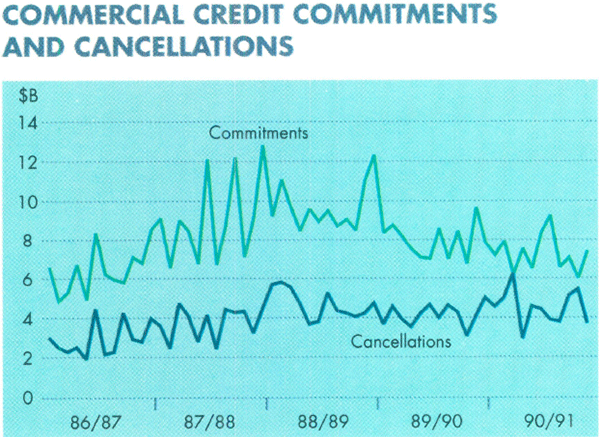
Prices for health services continued to rise quickly. In other service areas, however, prices were more responsive to market conditions. Costs of travel and accommodation, for example, rose by only 2.9 per cent in the year to March, reflecting the effects of airfare discounting and low occupancy rates.
The direct effect of higher petrol prices to private motorists following the Iraqi invasion of Kuwait added nearly a percentage point to the December quarter CPI result, and would have added to other prices indirectly through higher transportation costs. This effect, however, was short-lived, and petrol prices fell back in the March quarter. Increases in indirect tax rates and in various franchise fees and user charges levied by State Governments also contributed to higher prices. In part these increases reflected declines in State revenues as a result of the recession, particularly the fall in the volume of property transactions.
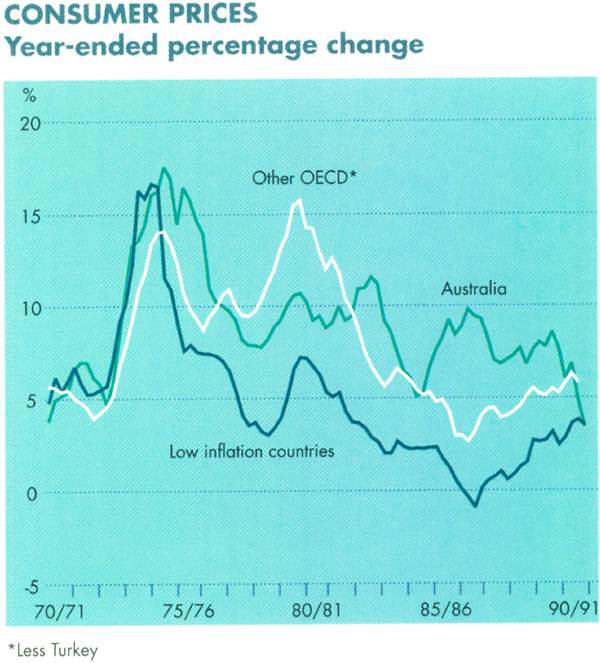
The general level of inflation in Australia over the past year has been the lowest for over twenty years. Falling mortgage interest rates have contributed to this, but even excluding these costs, the underlying CPI inflation rate is estimated to have been running at 4 per cent by the end of the financial year. This placed Australia's CPI inflation rate well within the OECD average, and not far above those of the low inflation countries; during most of the 1980s, Australia's inflation rate was substantially above the OECD average.
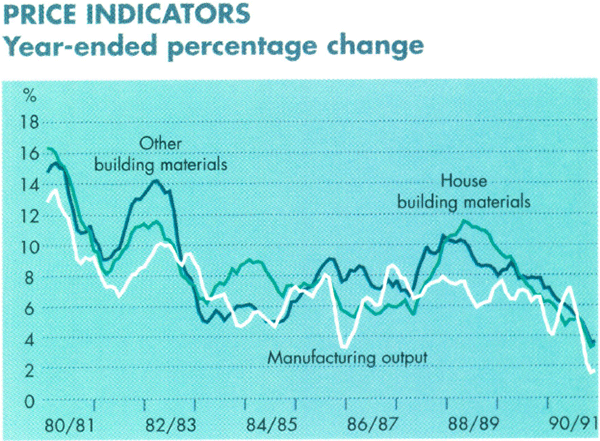
Product prices, as distinct from consumer prices, recorded even smaller increases. The index of articles produced by manufacturing rose by 1.8 per cent in the year to May. Prices for building materials also rose slowly mainly reflecting cyclical conditions in that sector. The broadest measure of product prices – the GDP deflator – rose by 2.6 per cent in the year to March 1991, the smallest annual rate of increase since 1967.
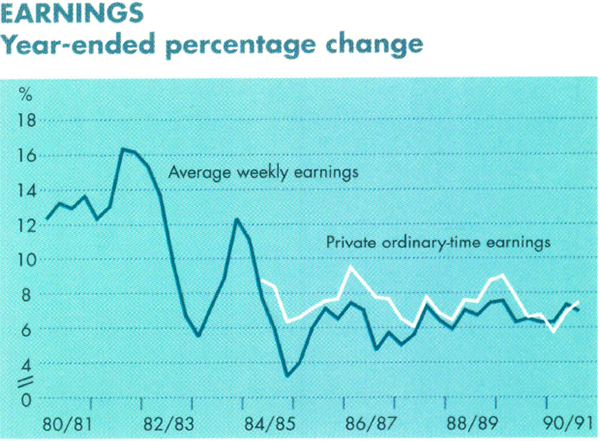
While much of the fall in inflation over the past year or two can be put down to the weakness in domestic demand, one foundation for lower inflation had been laid earlier by wage moderation. During 1988 and 1989, when the demand for labour was exceptionally strong, the growth of private sector earnings had picked up, reaching 8–9 per cent by mid 1989. While this contributed to upward pressure on prices, it was a much smaller rise than in 1981, when the labour market had last exhibited a similar degree of tightness.
| June 1989 | June 1990 | March 1991 | |
|---|---|---|---|
| Consumer Prices | |||
| – CPI | 7.6 | 7.7 | 3.4† |
| – Consumption deflator | 7.0 | 5.9 | 4.9 |
| – Retail trade deflator | 6.2 | 5.3 | 5.0 |
| Construction Materials | |||
| – House-building | 10.1 | 6.4 | 3.5* |
| – Other | 8.3 | 7.4 | 3.7* |
| Manufacturing Prices | |||
| – Articles produced | 7.0 | 5.4 | 1.8* |
| National Accounts Deflators | |||
| – GNE deflator | 6.6 | 5.2 | 4.2 |
| – GDP deflator | 8.8 | 4.1 | 2.6 |
| Earnings | |||
| – Average weekly earnings | 7.4 | 6.3 | 6.9 |
| – Private ordinary-time earnings | 8.7 | 6.7 | 7.5 |
| * Year to May. † Year to June | |||
In 1990, with the economy slowing, growth in earnings moderated. This development was helped by the low CPI result for the September quarter of 1990 and the decision to replace an increase in award wages based on that result by a broadly equivalent tax cut. The recorded figures for wages growth picked up a little at the end of 1990 and early in 1991, but this seems to have reflected compositional changes in the workforce, with the underlying growth in private sector earnings estimated to be running at around 6 per cent.
Outlook
The economy appears to have bottomed: the cyclical turnaround in stock-building seems to have started, housing – traditionally in the vanguard of an economic upturn – has been showing signs of recovery, and exports are growing strongly. Business confidence, while still subdued, is less pessimistic than six months ago. These factors suggest that recovery should get under way in the second half of 1991. The pace of this recovery is likely to be somewhat slower than recoveries from previous recessions, in part because of the corporate debt overhang and in part because policies are expected to remain relatively firm. This could limit the size of the increase in employment during 1991/92, although the trend in wage costs will also be critical in that regard. While the current account deficit has been reduced in 1990/91 some of this reduction reflects cyclical factors which will be unwound as the economy recovers. The strength of exports over recent years is evidence that structural change is occurring, but more is needed.
The main task for monetary policy in 1991/92 is to peg the progress which has been made on inflation over the past year, preparatory to winding it back further. Cyclical falls in inflation – where prices slow in response to weak activity – have occurred in the past, most recently in the early 1980s recession when inflation dropped from around 12 per cent in 1982 to a little over 5 per cent in 1984. On that occasion much of the gain was lost within a couple of years, an outcome which policy-makers are determined to avoid on this occasion.
A key factor will be the containment of costs. Actual inflation has fallen, and inflationary expectations also have moved down significantly. An important part of the ongoing process is for wage-setting over the coming year to embody these lower price expectations. That does not imply any reduction in real living standards; a decent productivity performance would allow goods prices to rise more slowly than wage costs. The structural changes and improvements in work practices which businesses and government instrumentalities have implemented during recent years should contribute in this regard as throughput rises during the upswing.
Having maintained a firm monetary policy during the downturn, there should be no question of allowing monetary conditions to ease too far during the recovery. The main focus remains the objective of achieving lower inflation in the medium term. Substantial weight will continue to be given to the evidence on inflation and inflationary expectations in the different sectors of the economy, and the extent to which these are being reflected in wage claims, in judging the extent and timing of future changes in monetary policy. The successful application of such an approach offers the best chance for Australia to regain the status of a low-inflation, low-interest rate and high-growth economy.